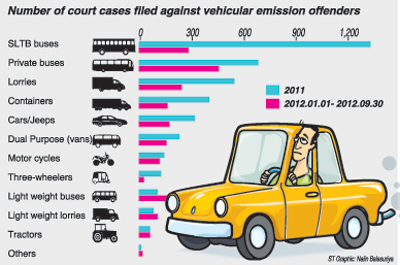News
New equipment to check and curb vehicle emissions
View(s):By Chamal Weerakkody
New equipment acquired by the Motor Traffic Department will enable more stringent tests including night checks on harmful vehicle emissions starting next year.
Motor Traffic Commissioner General S.H. Harischandra said random checks would be carried out on vehicles using the equipment, the first of its kind to be used in the country.

“Many vehicles are driven/used at night, so police are unable to detect the excessive smoke emitted. However, from January, with the new equipment, we can check vehicles at any time,” Mr. Harischandra claimed.
“The RMV has purchased 23 instruments to test diesel vehicles and 22 for petrol vehicles, to be distributed to each district in the country, to monitor heavy emitters of smoke,” he said.
Vehicles found with excessive emission on testing, will have their driving licence withdrawn, and given time to tune their vehicles and produce them to the RMV for inspection, after which, the driving licence will be returned, provided the vehicle is up to standard.
However, if the vehicle owner fails to produce a successful emission test report on the due date, legal action will be initiated against him/her.
The new laws will also deal with vehicle emission testing centres that issue bogus certificates to vehicle owners, despite vehicles not meeting the stipulated standards.
The Motor Traffic Department will be assisted by the Traffic Police, the Measurement Units, Standards and Services Department and the Central Environmental Authority in implementing the new laws.
According to both Environmental and Motor Traffic Acts, petrol vehicles other than motorcycles and motor tricycles, should have 4.5% by volume of Carbon Monoxide (CO) and 1200 parts per million by volume of Hydrocarbon (HC), and for motorcycles and tricycles the limit is 6% for CO and 9,000 for HC.
Commissioner General Harischandra added that tax concessions have been given to promote and encourage the use of hybrid and battery operated vehicles which do not emit pollutants and are eco-friendly.
Traffic Police Director SSP K. Arasarathnam said that owners of dual purpose vehicles and heavy vehicles are the main culprits, as they neglect the maintenance of their vehicles.
He stated that it is mandatory for a vehicle owner to be in possession of the vehicle emission test report among the other mandatory documents. Failure to possess them would result in fines ranging from Rs 3,000 to Rs 5,000.
Central Environmental Authority (CEA), Director General Ramani Ellepola said that excessive fuel burned in vehicles, generate emissions such as Hydrocarbons, Nitrogen Oxides, Carbon Oxides and also unburned carbon which produce toxic pollutants that defile the atmosphere and harm the environment.
“Liquefied natural gas (LNG) used as an energy element should be promoted for local transportation to reduce the increased rate of vehicular emissions” she said.
Health Ministry’s Environment and Occupational Health Director Dr. Ananda Jayalal told the Sunday Times that medical conditions associated with air pollution are on the increase.
Among these are asthma, lung cancer, cardiovascular issues, respiratory diseases, birth defects, and premature death
He said that the introduction of electric trains for public transport to avoid release of excessive smoke by present-day diesel engines would be beneficial.
Driver Improvement Points (DIP) system next year
Under this system, motorists who accumulate between 18 to 23 points within 24 months would be given a warning by the Commissioner-General of Motor Traffic, and their licence cancelled if they exceed 23 points.
In the case of those holding an Instructor’s Licence, two consecutive suspensions within four years, will make him or her liable to the cancellation of their Instructor’s License.
There is also provision for the remission of a period of suspension, if the offender participates in a training programme.
The highest number of 10 points will be imposed on motorists for offences such as failure to stop after an accident on a highway and to furnish relevant information, failure to report an accident to the nearest police station or driving a vehicle that is likely to cause danger or harm to people, property or other vehicles.
Reckless or dangerous driving or driving at excessive speed on a highway will incur 8 points. Other offences liable for points accumulation will be for exceeding the prescribed speed limits (6 points); overtaking vehicles without a clear view of the road ahead (6); failing to comply with oral directions or hand signals of a police officer or a traffic warden (6); driving a motor vehicle which has emissions above the prescribed standards (6); using or permitting to use amplifying equipment in a vehicle with a volume in excess of the prescribed standards (6); failure to wear a seat belt or failing to ensure the front seat passenger wears a seat belt (3); failure to give way at a zebra crossing while a pedestrian is at the crossing (6).
Follow @timesonlinelk
comments powered by Disqus




















